Water Balance
We must output how much urine per day
500mL
Why must we output 500mL of urine per day
Waste removal
1/47
There's no tags or description
Looks like no tags are added yet.
Name | Mastery | Learn | Test | Matching | Spaced |
|---|
No study sessions yet.
48 Terms
We must output how much urine per day
500mL
Why must we output 500mL of urine per day
Waste removal
Urine output can be as high as what
18L per day - if 10% of normal GFR is being absorbed (normally 99% is reabsorbed - don’t need to know 99% - just context)
What is considered sensible & insensible water loss
Sensible water loss can be easily measured (urine)
Insensible water loss can’t be easily measured - through skin & lungs
Insensible water loss can be as high as what during exercise & in hot conditions
Can be as high as 3.5L/hr from skin during exercise and in hot conditions
Sources of input of water into our system
Food
Drink
Metabolism (water is a waste product of metabolism)
Water output routes from the body
Urine
Faeces
Evaporation
Exhaled air


Water moves from a region of high/low osmolarity to a region of high/low osmolarity
Water moves from region of low osmolarity to region of high osmolarity
Under normal circumstances is osmotic pressure inside and outside cell equal
yes
What measures water conc. in the body
Osmoreceptors - they sense Posm
Where are osmoreceptors located in the body
Paraventricular Nucleus (PVN) of the Hypothalamus
Changes in osmoreceptor activity leads to the regulation of what
ADH secretion by the posterior pituitary gland
What are the main cells that are responsive to ADH in the kidney
the CNT (Connecting Tubule) cells and Principal (P) cells are the main ADH-responsive cells in the kidney - they are in the distal nephron
Normal osmolarity of cells & the ECF
280-300 mOsm/L
Osmoreceptors fire above ____mOsm/L - triggering the release of ADH
Osmoreceptors fire above 290mOsm/L - triggering the release of ADH
why is osmolarity so tightly controlled
↑ ECF Osmolarity → Cells shrink
↓ ECF Osmolarity → Cells Swell
What is Arginine Vasopressin (AVP) (or Vasopressin (VP))
ADH
ADH is a peptide made of how many amino acids
9 - it is a nonapeptide
ADH is broken down where
Liver
Is ADH fast/slow acting
Fast
Is ADH cleared by the kidney & degraded by the liver fast/slow
Fast - osmolarity needs to be tightly regulated (minute-to-minute)
Where in the nephron is responsible for creating a water-saving environment in the kidneys
Loop of Henle
Vasa Recta
How does the loop of Henle create a water saving environment
Interstitial osmolarity gets higher as you go deeper from the cortex into the medulla of the kidney.
The descending limb of the Loop of Henle is permeable to water but impermeable to solutes.
The water gets pulled out of the descending loop of Henle into the interstitium to balance osmolarity

What happens in the ascending loop of Henle
The (thick) ascending limb is impermeable to water but actively transports Na⁺ into the interstitium.
There is a unique arrangement of medullary peritubular capillaries (vasa recta) that allow for the recycling of urea between the loop & the collecting duct
We like to make the medulla hypertonic for lots of water reabsorption. How do we make the medulla optimally hypertonic
Transport salt, but not water, out of the loop of Henle and into the interstitium (the “single effect”)
Problem: Salt transport can only achieve a limited degree of hypertonicity. How do we magnify the degree of hypertonicity to achieve 1200 mOsm? - Countercurrent multiplication
How does countercurrent multiplication work
As the descending limb descends deeper into the medulla, it becomes more concentrated with solutes (like sodium and chloride) as water is reabsorbed into the body. This causes the filtrate to become more concentrated the deeper it goes.
The ascending limb pumps out salts but is impermeable to water, so it becomes less concentrated and makes the surrounding interstitial fluid more concentrated.
The water reabsorbed from the descending limb is taken away in vasa recta but the salt pumped out into the interstitial fluid of the medulla is not - this increases the medullary osmolarity without dilution from the water released.
The absence of ADH will result in urine with higher/lower osmolarity
Lower
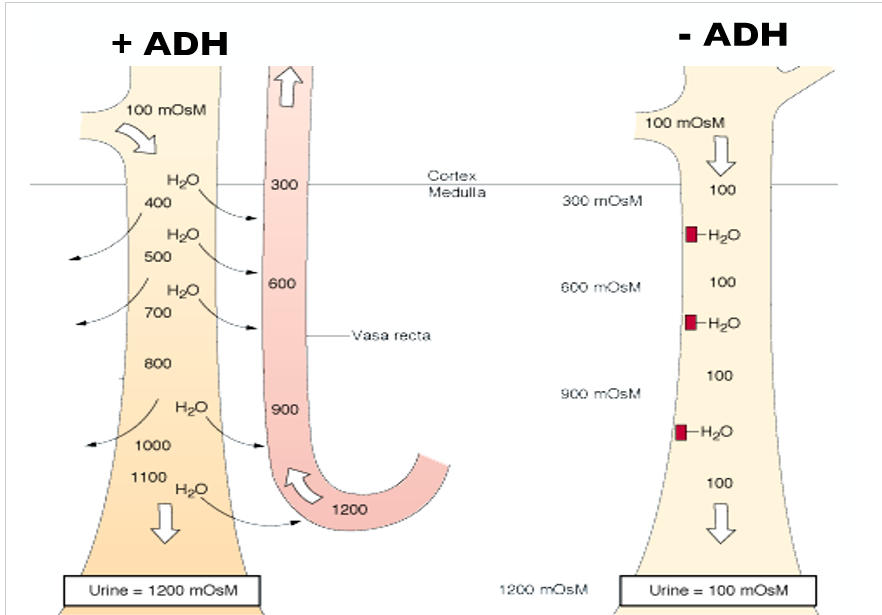
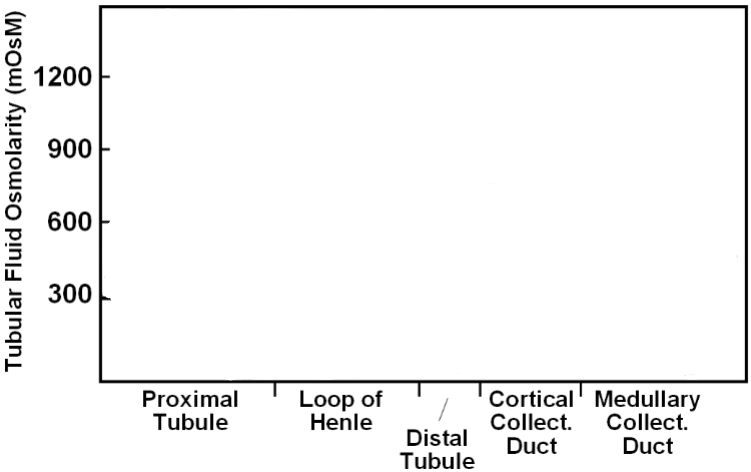
fill in the line of the graph to show the change in osmolarity of tubular fluid
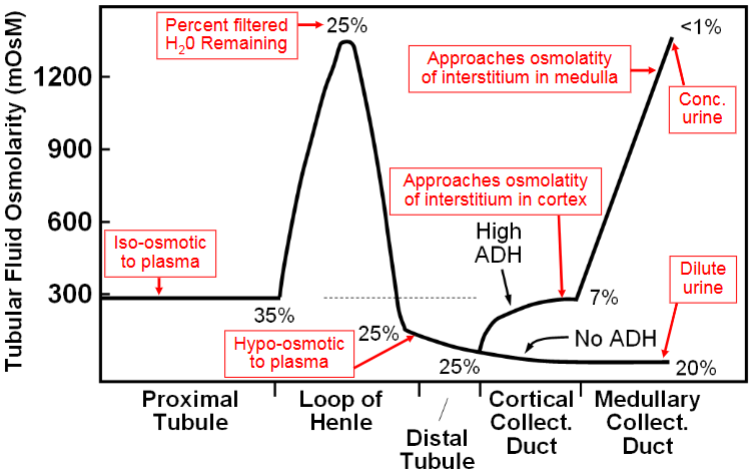
An increase in blood volume is detected by what
Baroreceptors
Volume receptors
Tonic firing of baroreceptors & volume receptors due to increased blood volume has what effect
Their tonic firing inhibits the supraoptic nucleus (SON) and paraventricular nucleus (PVN) of the hypothalamus, which are key centres for vasopressin (antidiuretic hormone, ADH) release.
ADH is not released. More water is excreted
An increase in plasma osmolarity is detected by what
osmoreceptors
If osmoreceptors are stimulated due to elevated plasma osmolarity what happens
They cause the release of ADH which makes the kidneys retain water

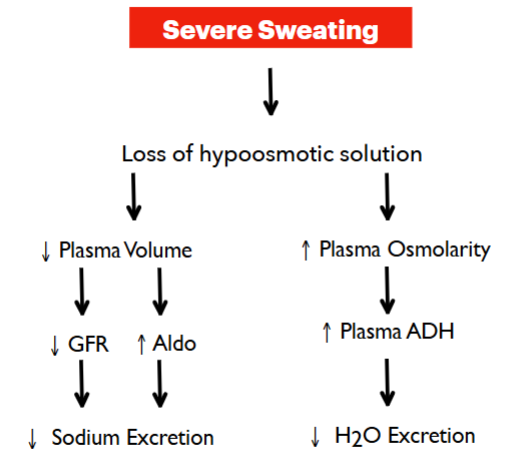
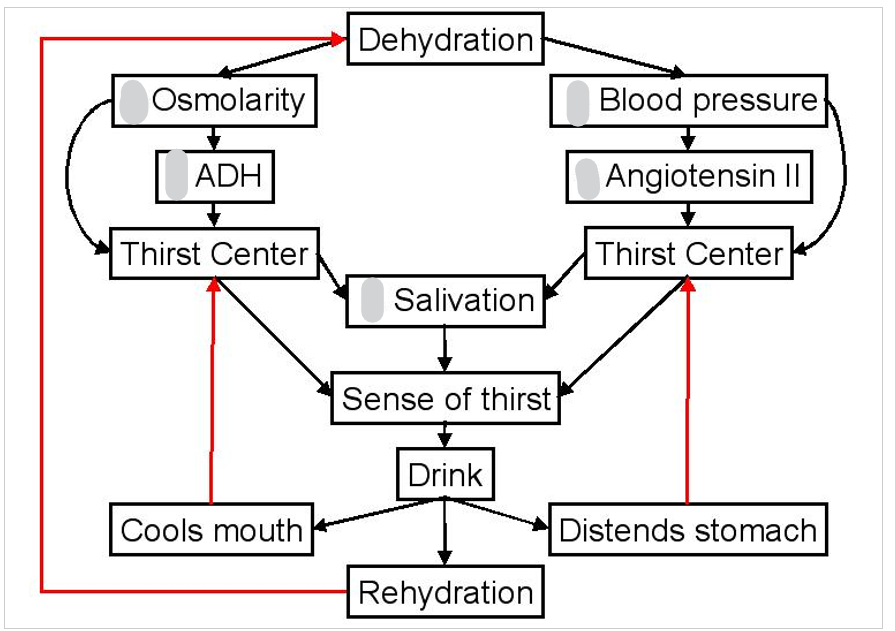

2 factors NB in the regulation of Urine
osmolarity & H2O balance
Where can you find a high osmolarity
Medulla of kidney
What regulates H2O permeability of CD (collecting duct)
ADH
What is the body’s response to hypovolemia
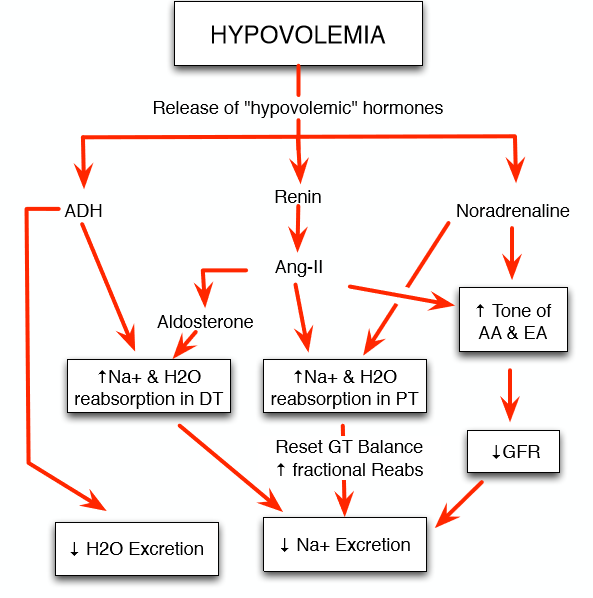
What is the body’s response to hypervolemia

We measure water balance by measuring what
osmolarity
Role of neurons in regulating a hyperosmotic state
Neurons shrink in response to surrounding hyperosmotic solution
They send more action potentials causing more ADH to be released
Change in osmolarity particularly effects neurons - neurons don't cope very well with osmotic challenges - this means almost nothing in the body is as tightly regulated as osmolarity
There is only 1 mechanism for saving water - what is it
create an osmotic gradient

can we make the blue 1200 any higher
Yes - with a longer loop of Henle
What are vasa recta in the kidney
capillaries that run parallel to the loops of Henle in the renal medulla. They play a crucial role in maintaining the countercurrent exchange system
How does ADH cause reabsorption of water
ADH causes the insertion of aquaporins in the collecting duct - water can’t normally escape from the collecting duct but it can now escape because of the aquaporins - water leaves the collecting duct due to the hyperosmotic environment outside the collecting duct
Effect of alcohol on ADH
Alcohol suppresses ADH - you pee loads on the night out. The next morning you are dehydrated & ADH is working on overdrive so you pee out a small dark pee because ADH is allowing the body to retain as much water as possible
The movement of water is always secondary to what
movement of salt